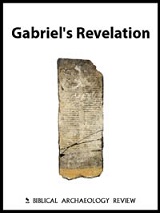Alan Millard examines the Proto-Canaanite script of the earliest alphabetic text ever found in Jerusalem

During excavations at the Temple Mount, Eilat Mazar discovered a lettered inscription featuring the earliest alphabet ever found in Jerusalem. The inscription precedes the development of the Paleo-Hebrew script used by the Israelites in the First Temple period. What does the inscription say? Alan Millard examines the evidence and current theories. Sherd: Ouria Tadmor, courtesy of Eilat Mazar. Drawing: Ada Yardeni, courtesy of Eilat Mazar.
During the 2012 excavations at the southern wall of the Temple Mount, archaeologist Eilat Mazar discovered an inscription with the earliest alphabet letters ever found in Jerusalem.
The inscription—carved on a storage jar—is written in the Proto-Canaanite script and dates to the 11th or 10th century B.C.E. In “The New Jerusalem Inscription—So What?” in the May/June 2014 issue of Biblical Archaeology Review, author Alan Millard provides a paleographic assessment of the inscription and explains how these earliest alphabet letters from Jerusalem can illuminate the scope of literacy during the time of David and Solomon.
This Jerusalem Proto-Canaanite inscription precedes the development of the Paleo-Hebrew script, which was used by the Israelites until the Babylonians destroyed the First Temple in 586 B.C.E. When the Judean exiles returned from Babylon, they brought back the square Aramaic script, which ultimately replaced the Paleo-Hebrew script. Both the Paleo-Hebrew and the square Aramaic scripts, however, were used together for hundreds of years.

The spectacular discovery of the inscription—the earliest alphabet letters found in Jerusalem—immediately inspired a number of epigraphers to attempt to translate it. Alan Millard notes that at least seven different readings have been proposed by as many eminent epigraphers.
This Proto-Canaanite Jerusalem inscription dates to a time before the direction of letters (whether they were read right to left or left to right) had been firmly determined and before a distinction between Hebrew, Aramaic and Phoenician had been established. Eilat Mazar has tentatively dated the wall in which the inscribed jar was found to the 10th century B.C.E.
Visit the BAS Scholar’s Study page Three Takes on the Oldest Hebrew Inscription to read assessments by scholars Christopher A. Rollston, Yosef Garfinkel and Aaron Demsky.
Alan Millard believes that we will likely never know with certainty what the earliest alphabetic text from Jerusalem says. What we can conclude is that the storage jar was inscribed in a place where ordinary workmen made pots, not in the lofty study of a royal scribe. Along with other early inscriptions, including the Gezer Calendar and the Qeiyafa Ostracon, Millard contends that this inscription from Jerusalem may signal widespread—if elementary—literacy during the time of David and Solomon.








